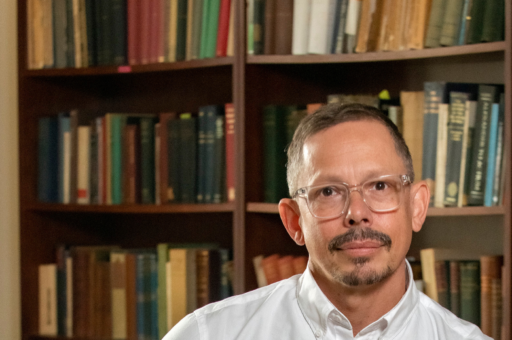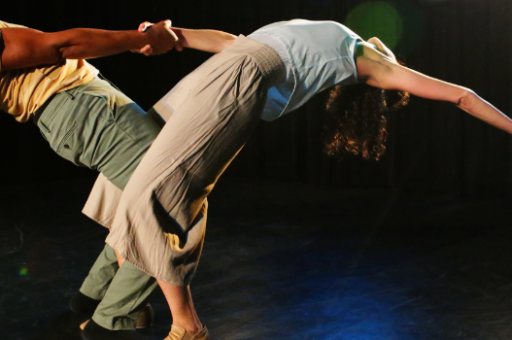Natalie Rouland (CBA ’18) is a scholar of Russian literature and ballet. She holds a Ph.D. in Slavic Languages and Literatures from Stanford University and has taught literature, film, and culture courses at Stanford, Miami University, and Wellesley College. Her research has been supported by the IIE Fulbright Program, the Fulbright-Hays Program, the Stanford Humanities Center, the Woodrow Wilson Center, and the Library of Congress.
For more about Rouland’s CBA Fellowship, visit her fellow page.
Please briefly describe your CBA Fellowship project.
At CBA, I have been writing the final chapter of my book Power on Pointe: Imperial Ballet and Russian Literature from Petersburg to Paris. In my book, I trace the development of Russian ballet in the late-nineteenth and early-twentieth centuries as part of a conversation with writers Lev Tolstoy, Mikhail Saltykov-Shchedrin, Nikolai Nekrasov, Anton Chekhov, and Anna Akhmatova. At the same time as the canonic Marius Petipa and Pyotr Tchaikovsky ballets in St. Petersburg, Tolstoy, Saltykov-Shchedrin, and Nekrasov critiqued the art form as outdated. In an era fraught with political turmoil and intellectual discontent, the glittering display of the tsar’s personal ballet company became a literal embodiment of all that was seductive yet corrupt about the Russian empire. Torn between desire for the eroticized dancers on stage and the need to voice dissent about the performers’ status as imperial property on the page, Russian intellectuals produced a cacophony of parables, parodies, and poetry around this disconnect. Yet by the time of Chekhov and Akhmatova, the worlds of literature and ballet coalesced in the experiments of Sergei Diaghilev’s Ballets Russes in Paris and the emergence of dancers as manipulators of their own power and celebrity. In my final chapter, I position the dancer and impresario Ida Rubinstein in this space of shifting market values, gender roles, and genre boundaries and consider why her legacy has been largely neglected. Overall, I argue that Russian writers played a crucial role in influencing the trajectory of Russian ballet and, in its later manifestation as a global phenomenon, the arc of ballet as a whole.

Costume for Ida Rubinstein in Le Martyre de Saint Sébastien, 1911
By Léon Bakst
From The New York Public Library
Who was Ida Rubinstein? How and why were you drawn to her?
Ida Rubinstein is a figure who has long fascinated and frustrated scholars. She was a dancer, actress, and impresario whose charismatic presence was so powerful that Anna Pavlova refused to share the stage with her following their performance in the 1909 Ballets Russes production of Cléopâtre. Independently wealthy, endlessly ambitious, and arrestingly beautiful with an androgynously slender form that was immortalized in the works of contemporary artists, Rubinstein performed in dance and drama, commissioned countless scores including Maurice Ravel’s Bolero for the productions that she starred in, and yet remained on the edge of artistic circles in Paris. She undoubtedly suffered from the anti-Semitism and misogyny of the era. Her status as a possessor of her own financial power, however, may been the most threatening: it led to her rivalry with Diaghilev, always short on funds, and enabled many to dismiss her as a dilettante, reinforced by her insistence on starring in spectacles that increasingly seemed like vanity projects.
I was drawn to Rubinstein’s unique position as a woman in charge of her own destiny, a survivor who refused to cede power and who prefigured pioneering American women in the performing arts such as Lucia Chase, whose passion for dance drove her founding and financial backing of American Ballet Theatre. In my chapter on Rubinstein and Akhmatova, I place Rubinstein in the heady and transgressive milieu of fin-de-siècle St. Petersburg. The themes of genre blending and gender bending that Rubinstein continued to play with throughout her European career spanning both world wars were key components of the artistic culture that flourished in the imperial capital on the eve of the Russian Revolution. Although Rubinstein left Russia for good in 1916, her works consistently hearken back to her geographic and temporal point of origin as an artist. In this sense, Rubinstein represents the ultimate émigré experience: the violent severing from an imperial past that is resurrected in glimmering stagings for a European audience alternately enchanted by and wary of this nostalgia.
During your seminar, you noted that Rubinstein has been mischaracterized as a “femme fatale” figure. Could you elaborate on that?
In order to understand Rubinstein, we need to understand the period of Russian modernism from which she emerged. The femme fatale was a popular archetype that transfixed creators of literary and performing arts in Russian Symbolism, but it was only one among many. Similarly, Rubinstein channeled queens, warriors, saints, sinners, classical heroes, and ancient goddesses in her works. Yet the femme fatale is the role for which Rubinstein has been remembered. This is partially due to her stage-stealing stints as Cleopatra and Zobeide in the Diaghilev ballets Cléopâtre and Schéhérazade. What we forget today is Rubinstein as Saint Sebastian in the 1911 mystery play Le Martyre de Saint Sébastien (score by Claude Debussy, choreography by Michel Fokine, libretto by Gabriele d’Annunzio, decors by Leon Bakst); as the Fairy in the 1928 ballet Le Baiser de la Fée (score by Igor Stravinsky, choreography by Bronislava Nijinska, decors by Alexander Benois); and as Joan of Arc in the 1938 concert-oratorio Jeanne d’Arc au Bûcher (score by Arthur Honneger and libretto by Paul Claudel). Her works testified to the diversity of subjects and styles with which she experimented over the forty-year course of her career: from her 1904 performance of Antigone in St. Petersburg to the 1948 production of her Lucifer, ou Le Mystère de Caïn in Paris.
As Russian modernism broke from the monolithic narratives of nineteenth-century ballet and the great Russian novel, it turned to the fragment, the bas-relief, the Grecian urn, and the epic poem. The use of new aesthetic forms to advance old motifs characterized Rubinstein’s work and informed the multiplicity of sources on which she drew for inspiration. Rubinstein simultaneously wielded sex as a manifestation of power, in the mold of the femme fatale, and renounced the flesh as the ultimate power play, in the rhetoric of martyrdom. This, combined with her androgynous appeal and proclivity for cross-dressed roles, created a dynamic persona in her performances on and off stage. In this sense, Rubinstein was truly avant-garde: steeped in the turn-of-the-century classicism of Isadora Duncan, Rubinstein anticipated the mid-century Tanztheater of Pina Bausch and the millennial performance art of Marina Abramović.

Costume for Ida Rubinstein in Salomé, 1908
By Léon Bakst
From the Tretyakov Gallery
In your book, Power on Pointe, you argue that “during the late imperial period, ballet as the embodiment of power and literature as the voice of protest transformed the reputation of Russian art and culture in the twentieth century.” How does Rubinstein fit into that narrative?
Rubinstein represents the culminating moment of the late imperial period. Before Rubinstein, dancers were primarily trained at one of the imperial theatre schools, funded by the tsar’s household budget, and as such were beholden to the imperial theatre system. This is the exact inequity that writers like Tolstoy, Saltykov-Shchedrin, and Nekrasov protested in prolific and vitriolic prose and poetry. The World of Art founders and subsequent Ballets Russes collaborators Diaghilev, Bakst, and Benois were raised on this rejection of the Russian imperial tradition, and realized the revolt of scenic and choreographic design in their Russian Seasons in Paris. Rubinstein was more than the first interpreter of two iconic Ballets Russes roles, Cleopatra and Zobeide. As a dancer who studied privately with Fokine, she also marked the shift away from the imperial system to the European free market in which ballets were commissioned, produced, and performed by private citizens, no longer imperial subjects, in an emerging professional infrastructure. Rubinstein both performed in and produced innovative new works during this exact moment of aesthetic and structural transformation. The Ballets Russes not only revolutionized the art of ballet itself: the way dancers were trained, ballets were funded, and productions were mounted changed when Diaghilev’s dancers stepped onto the boards of the Théâtre du Châtelet in 1909, with Rubinstein’s Cleopatra at the center of the artistic revolution.

Ida Rubinstein as Zobeide in Scheherazade, 1910
Photograph by Eugène Druet
From The New York Public Library
How do you see your work evolving following your CBA Fellowship? Do any questions or challenges remain?
The feedback that I have received during collegial discussions and following my formal presentation at CBA will continue to shape my work on Russian ballet. The unique opportunity to collaborate with scholars and artists, with historians and practitioners of dance alike, cannot be underestimated. The biggest challenge that remains for me is the development of a theoretical framework that accommodates a body of work as varied in scope, style, and execution as Rubinstein’s. I do not see the final chapter of my book Power on Pointe: Imperial Ballet and Russian Literature from Petersburg to Paris as my last word on Rubinstein. Whether my next project takes the form of a book-length biography or a chapter in a broader work on Russia’s ballet empire and its diaspora of dancers, Rubinstein will continue to inform my interest in artists on the margins and the power of performance.




